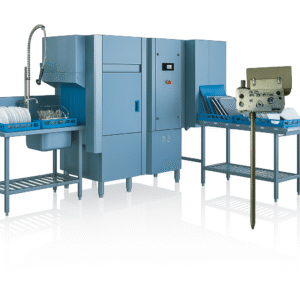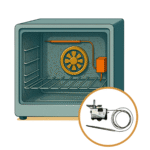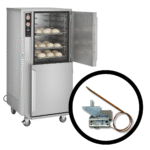Maintaining precise water temperature is critical in commercial warewashers to ensure consistent cleaning and meet health safety standards. Capillary thermostats in warewashers offer accurate, mechanical control of heating elements, helping dish machines achieve and sustain optimal performance in high-use environments.
→ To request OEM pricing, contact us.
 What Is a Capillary Thermostat?
What Is a Capillary Thermostat?
A capillary thermostat is a mechanical temperature control device consisting of four key components:
Temperature Sensor
Typically a bulb, the sensor is installed in direct contact with the water near the heating element. It contains a heat-sensitive liquid or gas that reacts to temperature changes.
Capillary Tube
This tube connects the sensor to the control unit and transmits pressure changes via the same fluid to the internal actuator.
Diaphragm
Located in the control unit, this element converts fluid pressure into mechanical movement.
Switch Mechanism
The mechanical motion actuates a switch, controlling the electrical circuit powering the heating element.
How Capillary Thermostats Function in Commercial Warewashing Machines
In commercial warewashers, capillary thermostats regulate water temperature to maintain optimal cleaning conditions. They can function as a temperature control to maintain setpoint range, or as a high-limit safety device to prevent overheating.
Installation
Install the sensor close to the heating element to accurately detect water temperature. The capillary tube routes to the control unit.
Operation
As water temperature increases, the fluid inside the sensor expands, increasing pressure in the capillary tube. This pressure moves the bellows, which triggers the switch mechanism.
-
When used as a temperature control, the switch opens when the water exceeds the setpoint and closes when it drops below the target range, cycling the heater to maintain consistent temperature.
-
When used as a high-limit safety, the thermostat cuts power if water temperature exceeds a defined safety threshold. In many designs, this switch remains open until manually reset, preventing operation until the issue is addressed.
Real-Time Feedback
This process creates a continuous cycle that maintains target temperatures with precision throughout cleaning and rinse stages.
Benefits of Capillary Thermostats in Warewashers
High Accuracy and Stability
Mechanical sensing enables rapid and precise response to temperature shifts, keeping wash temperatures stable even as water volume and load change.
Simple, Durable Design
Capillary thermostats integrate easily with existing systems and resist moisture, electrical noise, and vibration—common issues in busy kitchen environments.
Sanitary Consistency
Stable temperatures allow detergents and rinse agents to perform optimally, ensuring hygiene compliance and preventing rewash cycles.
Why Choose Capillary Thermostats?
Their mechanical reliability, temperature precision, and low maintenance make Stemco Capillary Thermostats a trusted component in commercial warewashing machines. Unlike electronic controls, they function without software, sensors, or external calibration, offering consistency even in rugged conditions.
→ For more information on our capillary thermostats, visit the product page.



